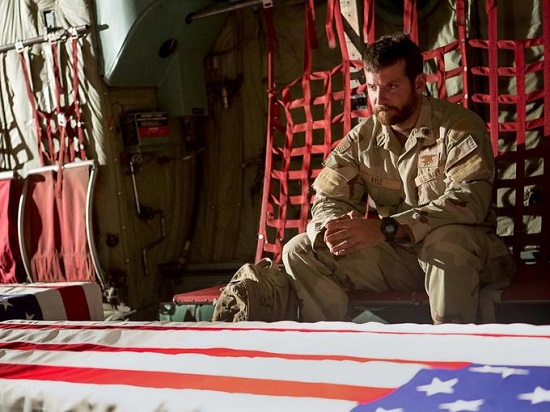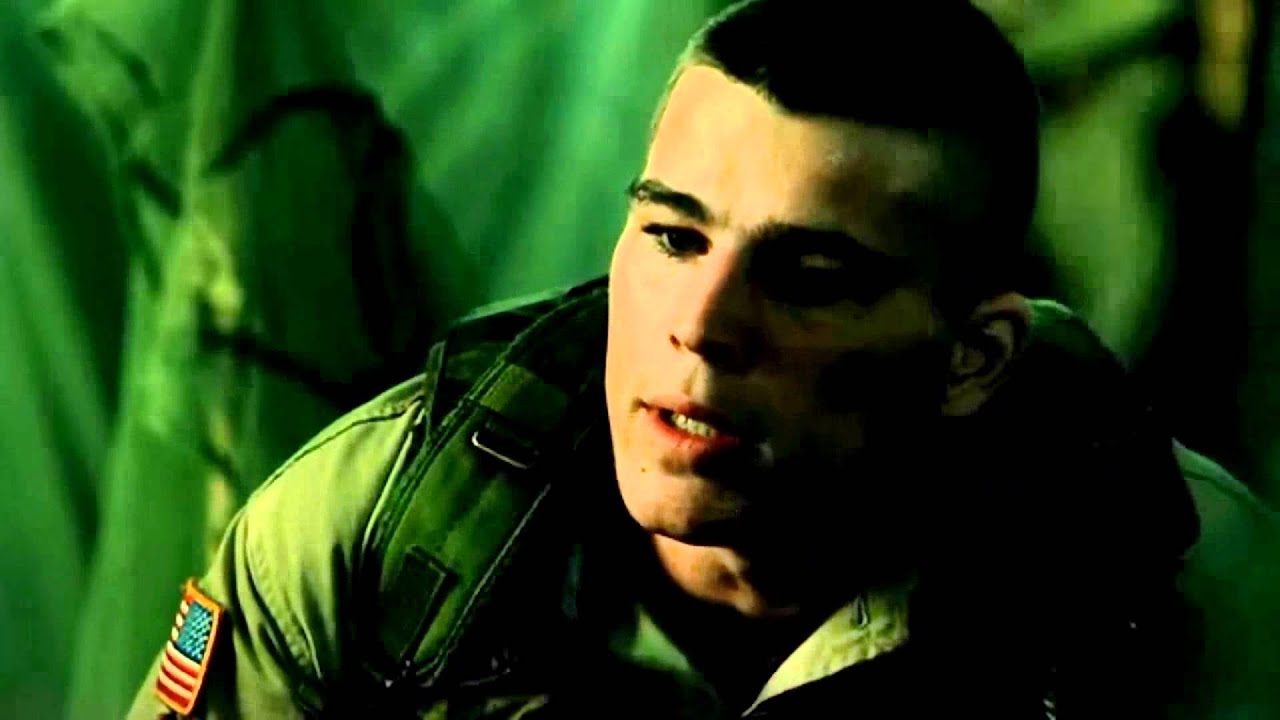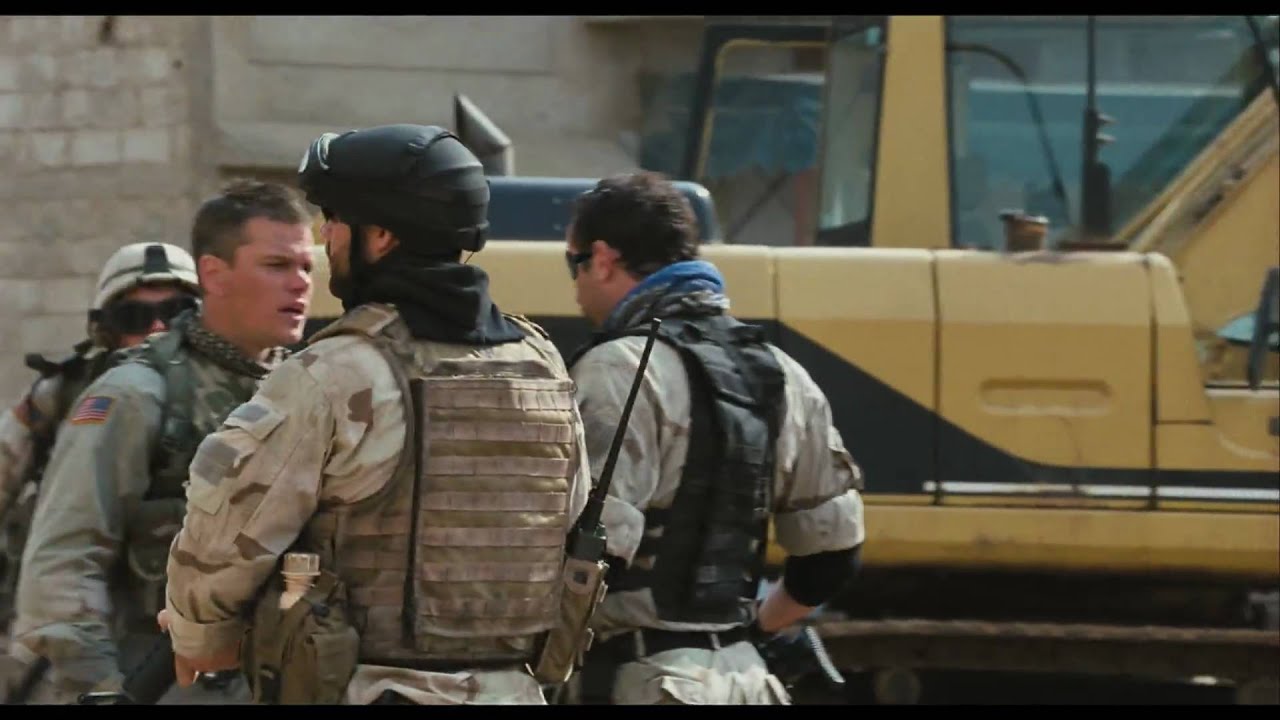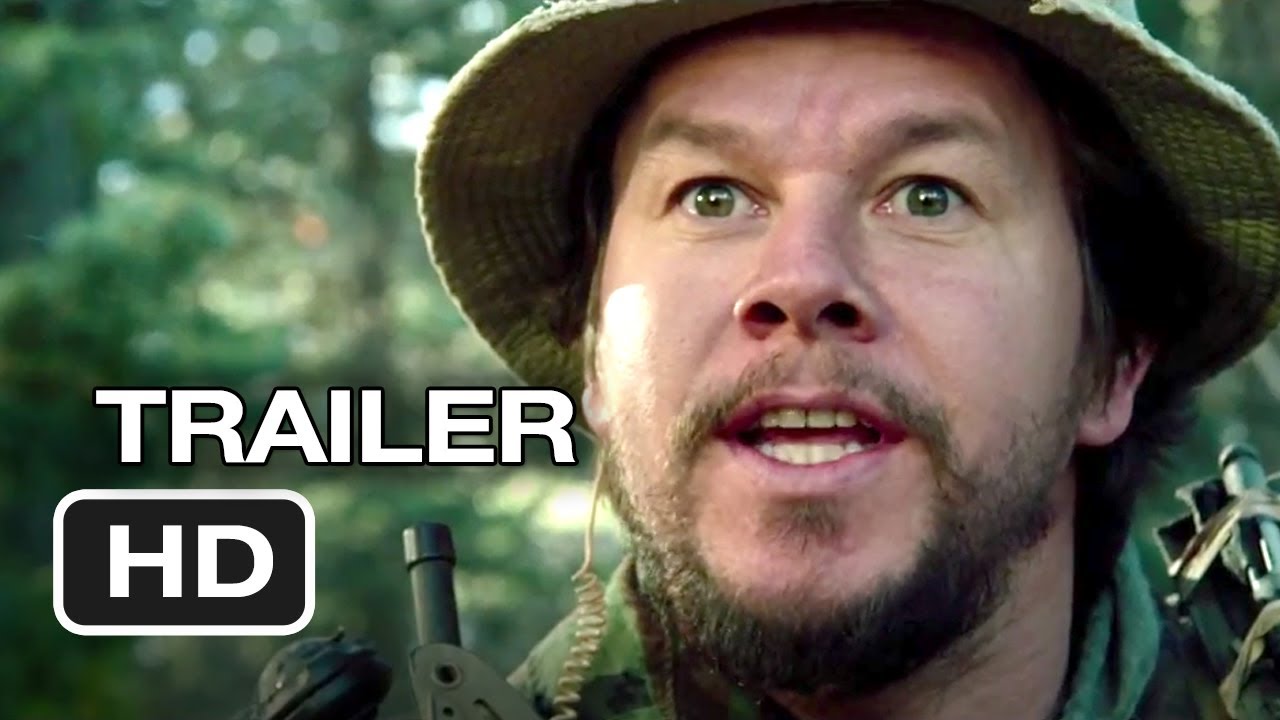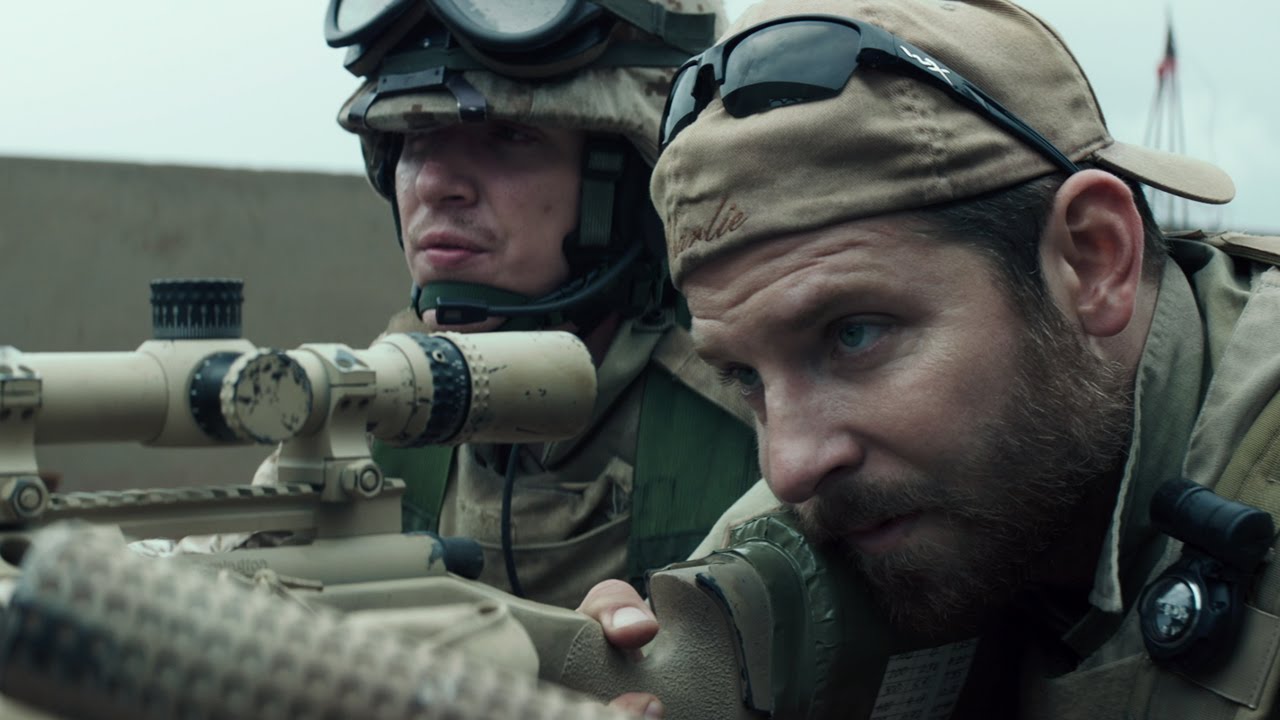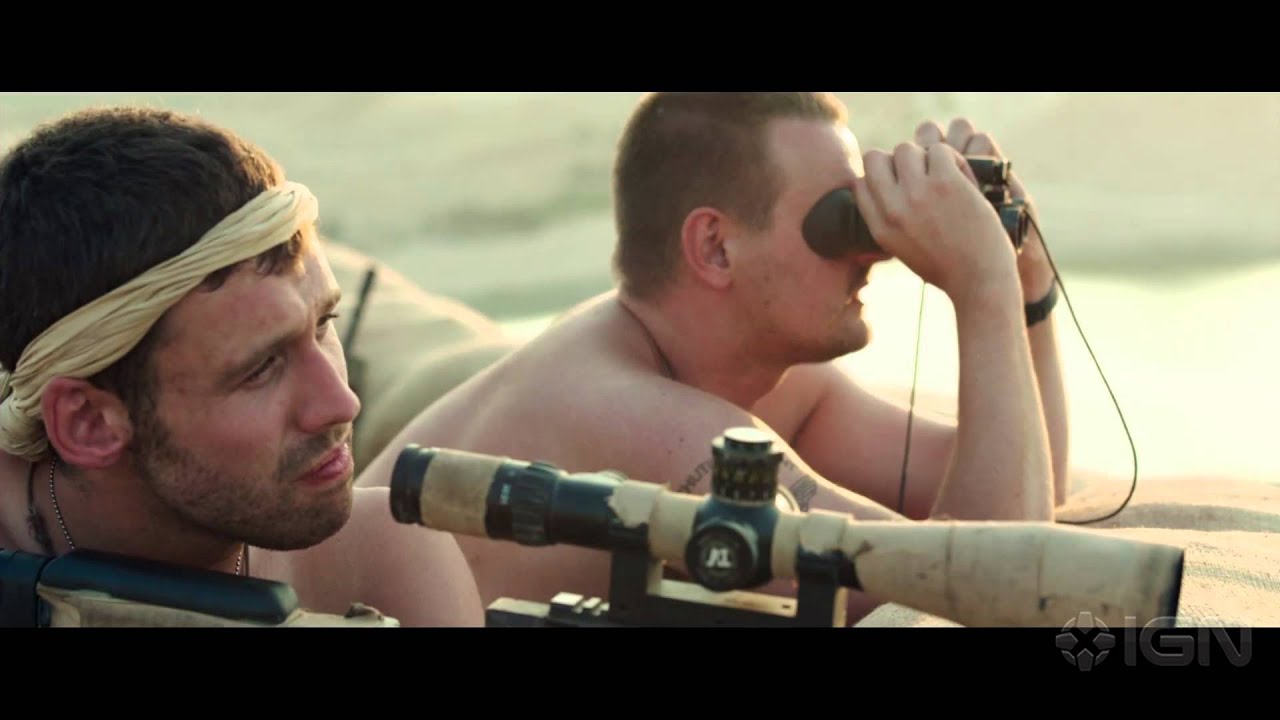The awards season has delivered a decidedly mixed verdict on American Sniper. To the surprise of some pundits, the film’s six Oscar nominations did not include one for director Clint Eastwood; the two BAFTA nods were for sound and best adapted screenplay; the Golden Globes ignored the film entirely.
In a year with plenty of strong contenders for leading man, Bradley Cooper’s third successive Oscar nomination is perhaps therefore a significant achievement to be highlighted, rather than looked at as an aberration given the other juries’ decision to overlook him. It’s not as if he didn’t give the part of US Navy SEAL sniper Chris Kyle his all: Cooper went on a 5000-calorie-per-day diet and spent two hours a day with a dialect coach, five days a week, for four months to perfect the Texan’s complicatedly nuanced brogue. And his performance is truly remarkable – an outstanding advertisement for the actor’s versatility, and an object lesson in how to inhabit a character.
Yet the lack of unanimity about the film perhaps reflects something more substantive than awards-season release scheduling, back-channel studio politics and the inevitable subjectivity of the voters. Maybe it suggests that cinemagoers and industry insiders are as uncertain about and ambivalent towards the conflict the film documents as the rest of us.
America’s recent wars have by default been the western world’s wars, but they have been characterised by, at best, confusion and a lack of clarity at home. The Iraq war was launched under clouds of dissent, reliant on dodgy dossiers and defectors’ claims about weapons of mass destruction which stand revealed today as either phantasms or fabrications. The concurrent conflict in Afghanistan, which started first, became just as contentious: the basic strategic premise, that a stable, democratically governed Afghanistan could no longer give safe harbour or training opportunities to those who would bring death to the streets of New York, Washington, London, Madrid or Paris, got lost as the death count climbed and the public support for the mission – and sometimes even for the military – plummeted.
It’s little wonder, then, that filmmakers remain in a state of some confusion about how to tell the stories of these two conflicts. For starters, who are they making these films for? Fans of action movies need clear narratives, bright explosions, escapist villainy and stereotypical heroism: Iraq and Afghanistan rarely deliver such clear contrasts. To a similar degree, these conflicts don’t easily lend themselves to the kind of anti-war polemic that attracts an intellectual left/liberal audience: there are too many grey areas and too many caveats for unambiguous statements to be made. (That audience, it appears, is being courted by Hollywood via documentaries and dramatisations of the politics around the wars and the concurrent issues about state surveillance, secrecy and hacktivism, from The Fifth Estate to Citizenfour, with Zero Dark Thirty a bridge between the two types but perhaps not terribly well suited to either audience’s needs.)
Worse, from the perspective of a would-be storyteller, these theatres of war are hard to understand and very difficult to represent visually. Where World War 2 offers a clear duality (right/wrong, good/evil), mirrored in the uniforms of the antagonists, which makes pictorial and dramatic sense, the counter-insurgency warfare of Iraq and Afghanistan has been carried out in what looks, to the untrained eye, as an often monochrome chaos. There are no front lines, and one set of combatants disguises itself as members of the general public – who are still living in the battle zone, trying to carry on life as normal.
The complicatedly chaotic fray American Sniper enters does have its antecedents, and they go back to before the start of George W Bush’s War on Terror. Ridley Scott’s Black Hawk Down remains in many ways a handy template for filmmakers assessing how to tell stories of the modern military, its overriding idea – to present the pages of yesterday’s newspapers in as compelling and involving a manner as filmmaking technology and techniques permit – seemingly the one most have followed since. It also came up against the same set of problems that have faced everyone attempting to bring the west’s 21st century wars to the big screen.
Scott was building on a formidable foundation: the incident portrayed in the film, where an American special forces mission to capture a warlord from the streets of Mogadishu in 1993 goes desperately wrong, was the subject of a series of articles published in The Philadelphia Inquirer and written by Mark Bowden, who later turned them into a book. The reporting was meticulous, extensive and deep: as well as interviewing as many of the participants as he could track down, Bowden went through hours of aircraft cockpit recordings and video footage shot during the operation, and took care to ensure the Somali side of the story was told just as thoroughly.
But the incident and its aftermath resist the inevitable simplifications that a two-hour film necessitates. The story focused on the Americans and was derided by some critics as racist; former Pakistan president Pervez Musharraf complained that the role of his nation’s forces in the incident had been deleted; and a number of American reviews claimed that the film acted – particularly given its late 2001 release, though work on it had begun long before September 11th – as an uncritical hymn to patriotism and an elongated advertisement for the US military. (This despite the facts that the incident portrayed not only failed in its objectives but had become what was, at that stage, the single largest loss of life sustained by American armed forces since Vietnam.)
America’s military misadventures in Iraq would go on to provide ample source material of similar strength, but many of the films inspired by the conflict are fictional. Kathryn Bigelow’s Oscar-winning The Hurt Locker reinforced the idea that filmmakers talking about these wars ought to aim for verisimilitude: the film was praised by critics, disparaged by soldiers, and largely ignored by audiences. It remains the lowest-grossing Best Picture winner of all time.
Perhaps more indicative of the direction Eastwood has taken with American Sniper was Paul Greengrass’s Green Zone. The film, which reunited Greengrass with his Bourne sequels star, Matt Damon, is based on the real-life search for weapons of mass destruction and was developed after Greengrass optioned the nonfiction book Imperial Life in the Emerald City by Washington Post correspondent Rajiv Chandrasekaran. Greengrass seems to have felt that the best way of drawing attention to the overarching issues he wanted to address was to tell a story that could point at larger truths while remaining unencumbered by an adherence to a necessarily open-ended storyline. There is a neat irony to be enjoyed in the fact that a director with a strong documentary background, whose achievement in thrillers has often been to make fiction feel more real, would choose to criticise governmental fabrication by preferring to tell a made-up story than a real one. In another, but far more tragic, case of life and art crossing over, a scene from Redacted, Brian De Palma’s fact-based but fictionalised story about American soldiers raping an Iraqi woman and murdering her family, appears to have provided the inspiration for the murders of two American airmen at Frankfurt Airport in 2011.
Last year two other filmmakers, in their own ways, seem to have come to similar decisions with movies telling stories from earlier wars, which can both be read as having something to say about more recent conflicts. Fury follows a fictional American tank crew through the final days of World War II, but in a lengthy scene that has provoked much criticism, where the soldiers share a tense meal with two German women, writer-director David Ayer’s intent seems to be to encourage us ask questions about "collateral damage" that are more urgent now than ever; he brilliantly captures the surreality of life going on as normal in the midst of battle, yet audiences and critics appear to have largely chosen to interpret the scene from its surface textures rather than its murky, only-hinted-at depths. Yann Demange’s ’71 has helped turn the remarkable Jack O’Connell into a star, and is up for two BAFTAs, including Outstanding British Film. Its fictional narrative of a British squaddie left behind during a riot in Belfast is gripping, nuanced and provocative, and does not require a reading that is unrelated to the era it depicts to succeed. But the environment O’Connell’s Gary Hook must navigate – where everyone is a potential enemy combatant but nobody else is in uniform; where the wrong word (or in certain circumstances any word) could be your last; and where instant decisions have to be taken about who to trust based on zero experience and nothing but a hunch – is one that sits at the heart of what makes more recent wars so difficult to film.
The same issues are addressed by American Sniper‘s most direct antecedent, Peter Berg’s 2014 version of Navy SEAL Marcus Luttrell’s memoir, Lone Survivor. Like the fictional Hook, the real Luttrell’s life was saved by strangers he had a second or two to decide to trust; unlike Hook, Luttrell didn’t even speak the same language. Berg’s movie – like Eastwood’s – has been attacked as gung-ho flag-waving and departs extensively from the facts as outlined in the source material: but it has also been praised by some who served in the same area at around the same time as a vivid and faithful portrayal of the reality of the Afghanistan war, and even the harshest critics of the book feel that the film improves on it.
Luttrell was part of a four-man SEAL team airdropped into mountains in eastern Afghanistan in 2005 on a mission to determine whether a particular insurgent leader was present in the area. Their radio link back to base stopped working just before their hidden position, high on a mountainside overlooking a distant village, was discovered by three unarmed men herding goats. With their location compromised, but unable to call for backup or evacuation, the team ended up in a firefight with insurgents. By the time Luttrell was taken in by villagers days later, his friends were dead and a team sent in on a Chinook helicopter to find them had been killed when a rocket-propelled grenade hit the aircraft’s fuel tanks. He survived because the villagers, acting (much to Luttrell’s confusion) under an ancient code of hospitality, chose to protect him.
Luttrell and Chris Kyle were friends; the former wrote a book-jacket endorsement for the latter, and there is a section in Kyle’s book where he recounts hearing that Marcus was missing in action, and his relief when news breaks that he has been found alive. Both natives of Texas, their books follow broadly similar patterns, with childhood thumbnails quickly giving way to the terrifying exercise in being pushed beyond credible human limits that is the character-forging and team-bonding BUD/S (Basic Underwater Demolition/SEAL) training course, before moving on to their deployment to central Asia. Both men take pot shots at rules of engagement they see as dangerously restrictive, though Luttrell goes further than Kyle. Neither addresses what appears to the reader to be the inescapable fact that both would have been suffering from post-traumatic stress at the time they sat down with their ghostwriters to work on their memoirs.
After the training (which takes up nearly a quarter of the pages), Lone Survivor mainly sticks to the one harrowing incident. Luttrell inserts information he found out afterwards into the timeline – particularly about the vigil that took place at his family home while he was missing. American Sniper is more of an overarching autobiography, Kyle’s claim to fame when it was written being his having killed more enemy combatants than any sniper in American military history, something that clearly takes a long time to happen. The films adhere to these same basic structures but the points at which each movie departs from the book are revealing.
Berg’s depiction of Luttrell – the 6’5" SEAL is played by the 5’8" Mark Wahlberg – goes to some lengths to downplay his political views and make him more palatable for a middle-of-the-road audience. The most contentious part of the book comes immediately after the SEALs’ position has been discovered by the goat-herders. According to Luttrell’s book, a debate took place between the SEALs, who all recognised that it was likely that news of their presence would be passed on to the insurgents within minutes once the goat-herders were sent on their way. Unable to call for evacuation, they discussed whether to release the men and face a firefight for which they were ill equipped and vastly outnumbered; or give themselves a better chance of survival but break the rules of engagement, not to mention the Geneva Conventions, by killing the unarmed men. According to his book, Luttrell says that the team leader, Lieutenant Michael Murphy, put the issue to a vote: Murphy’s father strongly denies that his son would have considered executing the farmers in cold blood and also argued that Murphy, as leader, would definitely have taken the decision himself and would not have allowed a vote to take place. Without actually backtracking in public, Luttrell has gradually distanced himself from that passage of the book: suggestions have been made that his ghostwriter, working from interviews that were not recorded and writing after Luttrell had gone back to serve another tour in Asia, may have misinterpreted him, and Berg told movie journalist Jeff Goldsmith that he was convinced that no vote had taken place. The film follows that interpretation, with Murphy taking the decision after a discussion between the men. Luttrell is portrayed in the film as arguing in favour of releasing them – a decision he says in the book he came to reluctantly, and only largely because, in effect, he had more fear of the media and courts in America than he had of being killed by insurgents in Afghanistan. Also curious: the beginning and end of the film show Luttrell briefly dying on a life-support machine as he is helicoptered back to safety. Not only did this – as with the preposterous shoot-out between villagers and Taliban that gives the film a ridiculous ending worthy almost of The Player – not happen, Luttrell took great pride in walking off the aircraft on arrival at Bagram, though he was unable to make more than a couple of steps and was hospitalised immediately afterwards.
Berg seems to have wanted to make Luttrell a more appealing hero by simplifying his reaction to the encounter with the goat-herders, yet he still feels the need to use tired action-movie cliches to bring an already arresting story to a conclusion believed fit for cinemagoers. Given the care taken with so much of the film – from the patches Murphy wore in honour of New York firefighters killed on September 11th 2001 to ensuring that bullets fired from SEAL 5.56 rifles sound different from those fired by their adversaries’ AK-47s – the parts where it diverges from reality are jarring.
Exactly the same thing happens in American Sniper, but in entirely different ways. The film deletes most of the passages from the book where Kyle’s views would have alienated left-leaning audiences, and – crucially – adds in scenes emphasising how the war took its toll on him, too: reading the book, you see this between more or less every line, yet Kyle studiously avoided anything which might make him appear a victim. The reasons for these changes in the film are obvious enough: Kyle’s book made him a minor celebrity, and the post-military work he began before writing it, with traumatised fellow veterans, was only beginning before he became a best-selling author. The film takes his life story to its desperate and dramatic conclusion, beyond the end of the book’s timeline – avoiding detail presumably because Kyle’s apparent murder remains the subject of an ongoing court case.
It is telling that Eastwood – who is no longer registered as a Republican but voted for John McCain in 2008 and supported Mitt Romney in 2012, yet who supports gun control and appears to find his own positions on political issues rather than sing from a party-approved hymn sheet – would appear to wish to depoliticise Kyle. The latter felt he was apolitical, and displays a tetchy impatience with lawmakers who seek to control the military without understanding it, so the portrayal perhaps honours the late SEAL’s self-image. Yet if it was in any sense an attempt to ensure the story could cut through partisanship and ensure the subtexts around Kyle’s story could be understood and appreciated across the political spectrum, it is a tactic that has conspicuously failed. The director has called right-wing praise for the film as pro-war "stupid", yet the same critique is being made by the left, albeit for the opposite reasons.
Those who approach the film from a politicised position are able to make
it say whatever they want it to say. To the right, the movie eulogises an
all-American hero which means it sticks one in the eye of liberals. To the
left, Eastwood isn’t making an anti-war (never mind anti-That War)
statement, and any attempt to portray Kyle as having the same human
stresses and frailties is a whitewash intended to glamorise the military-industrial complex. Both interpretations are, unfortunately, only encouraged by the abrupt way the movie deals with Kyle’s death. The facts are not shown nor the alleged motivations investigated, but a text-only screen leaves the audience in no doubt about how Eastwood wants us to interpret it. The details may never be known,
though there have been attempts made to get at them – and there are compelling legal reasons why Eastwood and the studio would not want to wade in to those waters, never mind dramatic ones about resolved narratives and the sanctity of the three-act structure. But by avoiding the messy complications, Eastwood hands critics of Kyle, the US military and the Iraq War an opportunity to dismiss the other points his film makes well, and – equally unintentionally, but equally unfortunately – gives succour to those who wish to see the conflict as a victory for American exceptionalism. By oversimplifying Kyle’s story, the movie allows us too easy a way out of its political and moral maze.
There are other changes to Kyle’s book which seem perplexing in more formal and less problematic ways. The opening scene, which appears in the trailer, is also the opening scene in the book: it comes early in Kyle’s first deployment, before he has shot anyone. Kyle is on top of a building, providing overwatch as soldiers go on a door-to-door patrol. A woman and child appear on the street: the woman hands the child a grenade, and the child starts to run towards the American troops. The scene is dramatic, compelling, and encapsulates the impossible job Kyle and others like him had. He has sole responsibility for deciding whether to shoot. If he does, and the boy is innocently running towards the soldiers to hand them a weapon he thinks they should be given, or if it isn’t a weapon at all, he will be court-martialled and sent to prison, as well as having to live the rest of his life knowing he has killed an innocent child. If, however, the mother has handed her child the weapon and turned him into a suicide bomber, and Kyle does not shoot, he will be responsible the deaths of fellow soldiers. What’s interesting for our particular purpose here is not the decision Kyle came to, the reasons for it, and how it affected him afterwards (though those are of course the crucial questions the scene requires us to consider) – what seems odd is that, in the book, there is no child, just the woman. The incident raises exactly the same issues and carries just as much weight, but at some point in the process – perhaps when Steven Spielberg was attached to direct, before Eastwood got involved – a decision was taken that adding a child to the equation would make for better cinema.
Several of the key set pieces in the film are composites drawn from different thumbnail sketches that played out at different periods in Kyle’s military career. A scene in which he is part of a patrol which is welcomed into an Iraqi home for a meal only to discover their host is an undercover insurgent with a stash of weapons under the floorboard does not appear in the book; though different elements of the incident take place in different contexts, in vignettes spread over several years. Mustafa, an insurgent sniper who becomes Kyle’s nemesis in the movie, has been beefed up for the film from a brief mention in a single paragraph of the book. Kyle did get credited with an extraordinarily long-range shot, but he was not shooting at Mustafa; there is no suggestion in the book that any kind of professionally respectful duel took place between the two. The climactic firefight around an overrun, ruined factory in a dust-storm, too, has been invented for dramatic purposes, some of its detail culled from different incidents. As a vivid illustration of "the fog of war" the sequence has few equals, and the way it speaks to more universal realities about the conflict it portrays arguably justifies its inclusion as written: but in what purports to be biopic such liberties feel excessive.
It is not as if there weren’t things in the book that would have worked well in the film – in particular, a sequence in which Kyle shot beach balls which insurgents were using as makeshift rafts in an attempt to attack American forces on the far side of a river is surely a vibrant, singular, highly visual and surprisingly unexpected vignette which could have helped show how this conflict differed from what those of us who have never been to war have come to think of as the norm. Instead, the conflation of fact and fiction, history and myth, leaves us everywhere yet nowhere – feeling we’ve maybe got some sight of an overarching truth, only to be discomfited by the knowledge that we’re being implicitly told, as if by a sotto voce Jack Nicholson impersonator, that we can’t handle it.
There is one film that manages to square these different circles, and it, too, has found its way onto the awards-season radar. Kajaki: The True Story is a remarkable achievement from any viewpoint. Innovatively financed and bypassing traditional distribution, with some money coming from online crowdsourcing and with a guarantee that 10 per cent of profits will be donated to charities working with ex-services personnel, the film was released initially only to Vue cinemas; it is currently screening in the UK at a number of Cineworlds, following an evidently successful social-media campaign to demonstrate a local demand and encourage cinemas to show it. Despite coming from outside the established studio and distribution system, and featuring a cast almost entirely made up of newcomers and unknowns, it has been nominated for a BAFTA in the Outstanding Debut by a British Writer, Director or Producer category.
The film tells the story of a 2006 incident involving members of the 3rd Battalion, the Parachute Regiment, during a deployment to a remote and Spartan hilltop base above the Kajaki dam in Afghanistan. The troops spotted that Taliban fighters had set up a road block and were preventing Afghan civilians from using the road. The position was too far away to open fire and the proximity of civilians meant calling in an air strike was impossible. Three soldiers decided to hike to a hilltop nearer the road block so they would be close enough to be able to fire on the insurgents. But on the way there, one of the soldiers stepped on a land mine left over from the Soviet occupation; his comrades rushed to his aid, only to set off further blasts. For several hours a growing number of soldiers were stuck in this long-forgotten minefield, waiting for helicopters to winch them to safety. But communication failures meant help was slow to arrive, and the first helicopter on the scene had no winch – in trying to get close enough to help, the down-draft of its rotors set off further mines.
The film’s great triumph – and a bigger differentiating point from American Sniper or Lone Survivor even than its lack of budget or marquee-name stars – is that it sticks to the facts without worrying about the cinematic consequences. As a result, it succeeds on every level, yet does so by seeming to break every rule in the book. It is the tensest of action films, yet contains no real "action" – there’s barely even any movement. Aside from a moment where one of the Paras is listening to the Kaiser Chiefs on his iPod during some down time, and a new song (‘All Of My Life’, written and performed by Phoebe Katis) that plays over the end credits, there is no music. The nearest the soldiers get to the Taliban is watching them through binoculars, yet the film shows the Paras in the fight of their lives.
The opening passage sets the scene and draws the characters sharply as they go about what has become normality for them in their remote moonscape surroundings. But when we follow Lance Corporal Stu Hale (Benjamin O’Mahony) down into the valley and the first of the mines is detonated, the focus switches to a tiny patch of land, no bigger than the average theatre stage, and stays there. For an hour and a half that cramped space between desert hills becomes the whole world. The slightest movement could mean death, yet the enemy isn’t someone pointing a gun or launching a missile but a machine buried in the dust a quarter of a century before, part of a different war entirely.
Inside this almost unbearably claustrophobic struggle, the film focuses not on the equipment inadequacies that the eventual coroner’s inquest highlighted, or on moralising about the point of the men being there or the purpose of the war itself: instead, director-producer Paul Katis and writer Tom Williams show how the troops got through the ordeal, with a mixture of swearing, excessively dark humour and astonishing self-control. There’s no blame-making, no recrimination, no posturing or point-scoring or political sermonising – which allows the viewer to let the film make whatever arguments they would like it to make far better than had they all been written in. Whatever perspective you come from, you can take what you want from this film: it is anti-war in that it shows how pointless everything was, yet is pro-military in emphasising the extremes ordinary rank-and-file soldiers will go to when they are called on to help and protect their comrades. The approach sounds simple yet is counterintuitive and mould-breaking.
"They promised they were going to tell the true story and keep all the Hollywood-type of effects out of it," Lance Corporal Paul "Tug" Hartley told Sky News in November. Hartley was one of two medics stationed at the Kajaki base and went into the minefield to treat the injured; at one stage, to get to another mine blast victim, he crossed the minefield by throwing his backpack onto the ground and, when it didn’t set off an explosion, jumping onto the pack and repeating the process until he had made it to the other side. He is played in the film by Mark Stanley, among the most prominent of Kajaki‘s stars after appearances as Grenn in 22 episodes of Game of Thrones. "I think they’re 99.9 per cent accurate about what happened that day," Hartley continued. "The only way you’re going to get the 100 per cent is to have been there with us."
The one concession to cinematic necessity is the compression of the timeline: the incident played out over several hours, and Kajaki is difficult enough to watch at its present duration. While nobody can guarantee that every word spoken on screen was said in Afghanistan that September day, the script was pieced together following interviews with the survivors who have said that it accurately portrays what took place. Nothing that didn’t happen was written in, and there is no attempt made to sandpaper off any rough edges to make the end result feel more conventional or acceptable as a piece of cinema. This possibly unprecedented fealty to battlefield accuracy makes Kajaki the standout dramatisation of modern warfare. Whether Hollywood will follow its lead remains to be seen.

